
EPA Diesel Emission Reduction Act – Collaboration
The Connecticut Maritime Foundation has successfully collaborated with EPA and regional maritime fleet partners to achieve significant emission reductions by replacing older more emissive marine diesel engines with newer, cleaner models. The EPA Diesel Emission Reduction Act (DERA) Grant Program is directly responsible for these projects as typically the cost of replacing engines without grant funding is prohibitively expensive. The DERA Program, therefore, allows fleets to either accelerate engine replacements or make the replacements in lieu of rebuilding the older diesel engines.
DERA Program Background
Since 2008, the EPA has been pursuing a National Clean Diesel Campaign that advances strategies to reduce diesel emissions and move toward cleaner air. EPA’s strategy to accomplish this has been to work with fleet operators, manufacturers, air quality professionals, environmental and community organizations, and state and local officials to put together targeted plans, including both regulatory and voluntary measures to reduce diesel emissions. The program enjoys strong bipartisan support in Congress and has consistently been reauthorized since its inception. A concise summary of the background, history, and current/future appropriations can be found here. Text of Link: https://crsreports.congress.gov/product/pdf/IF/IF11331
Diesel Emission Reduction Act
Because diesel engines can have such a long operating life (10-20 years or longer for marine engines), EPA realized that implementing cleaner regulations for new diesel engines would take a significant length of time to make an impact on local air quality. To achieve more immediate emission reductions, EPA sought a way to encourage fleet owners to voluntarily reduce diesel emissions. As a result, Congress authorized funding for clean diesel initiatives with the Diesel Emissions Reduction Act (DERA) as part of the 2005 Energy Policy Act.
Periodically, EPA announces the availability of DERA funds to be used for cost-effective emission reduction programs, with the focus primarily on reducing nitrogen oxide (NOx) and particulate matter (PM) emissions, although there is increased desire to also show fuel economy and therefore carbon dioxide (CO2) benefits.
Why Reduce Diesel Emissions
Two pollutants of primary concern from diesel engines are particulate matter (PM) and nitrogen oxides (NOX). In the atmosphere NOx reacts with volatile organic compounds (VOC) to produce ground-level ozone, a serious respiratory irritant. NOx also contributes to the formation of secondary particulate matter in the atmosphere.
PM particles formed by combustion of fossil fuels are a complex mixture of elemental carbon (EC), unburned or partly combusted fuel as organic carbon (OC), sulfate from fuel sulfur, and lubricant products (i.e., ash and additives). PM emissions are of substantial concern because they contribute to poor visibility and they negatively impact human health. EPA’s assessment of scientific evidence concludes that fine particle pollution causes both respiratory and cardiovascular problems, and can even cause early death.
The particulate matter of greatest concern are fine and “ultra-fine” particles with diameters of 2.5 microns or less; this portion of PM is referred to as PM2.5. In comparison, a human hair has a diameter of approximately 70 microns – ~25 times greater than the diameter of a PM2.5 particle. At this size, particles stay suspended in the air stream, and can bypass the body’s mechanical respiratory defenses and can embed deep in the alveoli of the lungs when inhaled — the smallest of these particles can also enter the bloodstream directly through the lungs. The vast majority of PM particles emitted by diesel engines are small enough to be classified as PM2.5. Additional information can be found on EPA’s Particle Pollution website. Text of Link: https://www.epa.gov/pm-pollution/particulate-matter-pm-basics
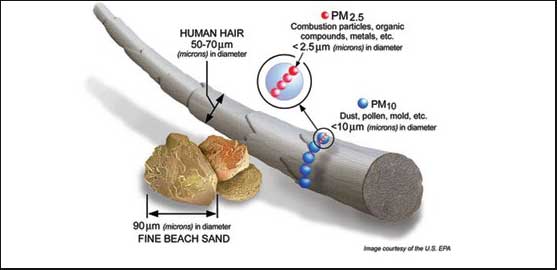
EPA Diesel Emission Reduction Act Projects
Significant and Meaningful Benefits
Since The Foundation began collaborating with EPA and fleet partners, a total of 10 marine vessels have undergone engine replacements to achieve significant emission reduction benefits. The Foundation’s collaborative projects have focused on New England, New York, and New Jersey and have involved five different marine fleet partners – some securing DERA grant(s) for more than one vessel.
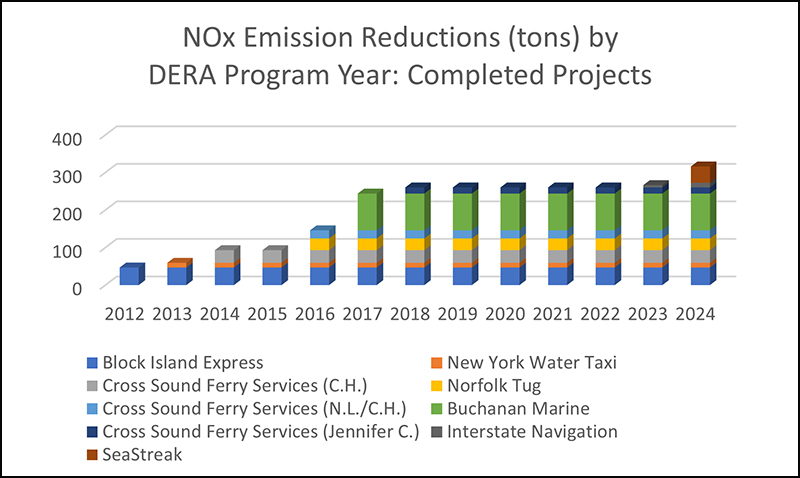
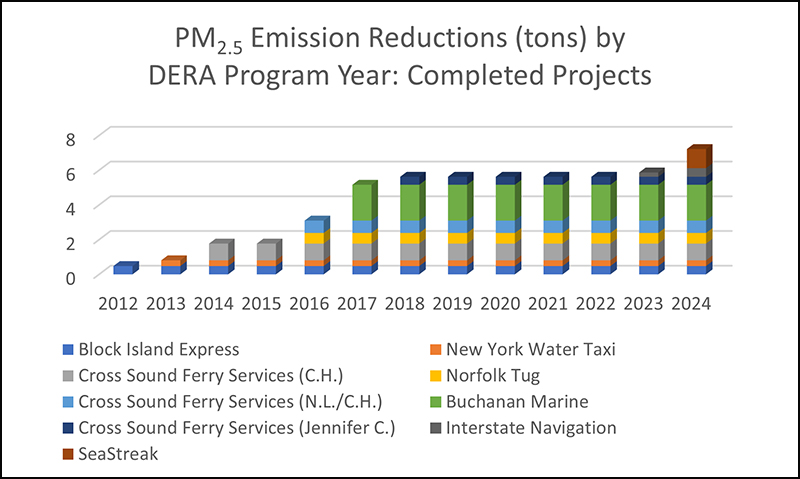
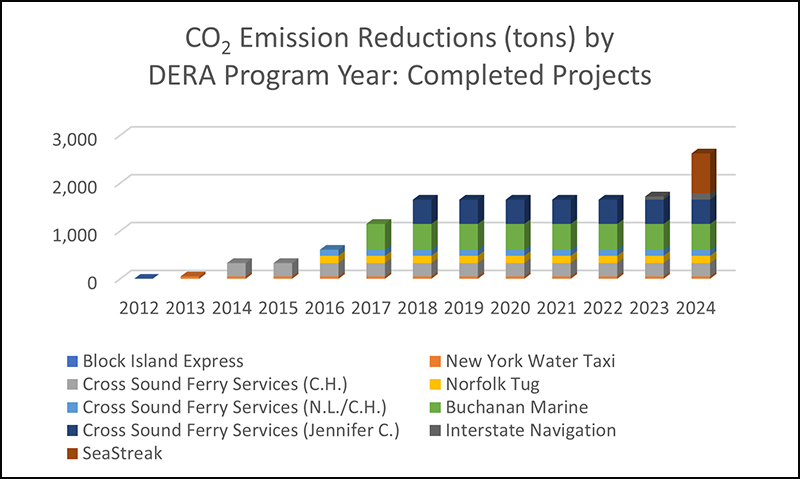
A helpful way to look at the benefits from these marine projects is in the context of health benefits and comparing to on-road trucking. EPA has a method of determining estimates of health cost savings that result from the reduction of PM2.5 emissions and cumulatively, the vessels already completed are projected to save $41.3 million annually, compared to one-time EPA grant costs of less than $7.2 million.
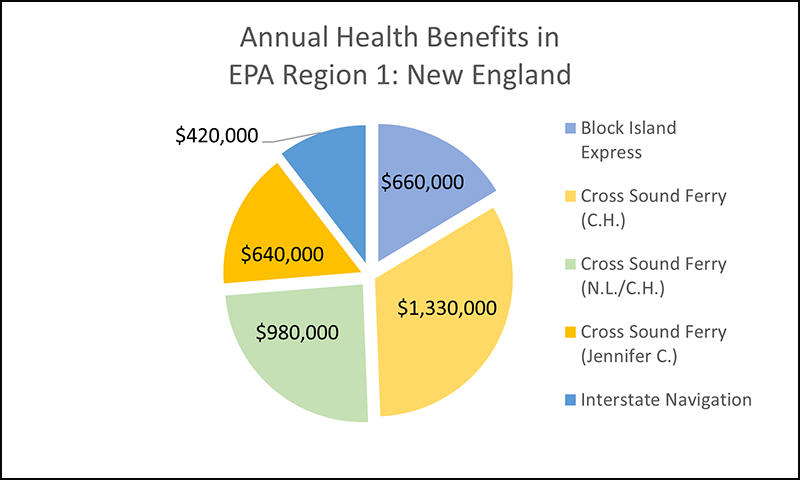
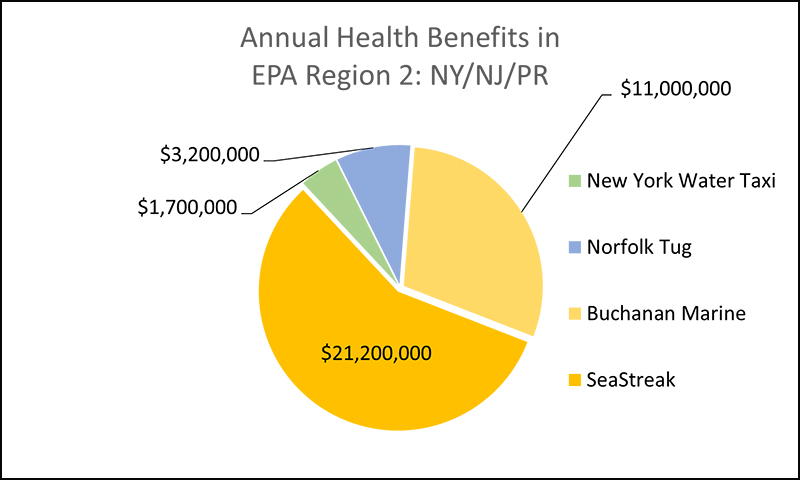
The emission reductions from all of The Foundation’s completed DERA projects combined are the same as taking approximately 981 combination trucks off the roads. This number will grow to nearly 2,000 once all current projects are completed.
DERA 2012 (Region 1) – Block Island Express: Jessica W.
The Jessica W. is a 160-foot tri-hulled marine fast ferry with a displacement of 451 gross tons that was originally built in 1990 and equipped with Tier 0 engines. Tier 0 engines are those built after 1972, but before EPA enacted emission control regulations for new marine engines. The vessel operates in service from New London, CT to Point Judith, RI and Block Island, RI in the summer and Orient Point, NY in the winter. The vessel was originally equipped with four propulsion engines, although during typical operation only two engines would operate. As a result, Block Island Express requested and was granted funding to replace two of the four propulsion engines. Outside of the EPA grant, the other two engines were also replaced at the same time.
M/V Jessica W Marine Engine Repower Project Details
This project replaced two existing pre-regulated Tier 0 engines in the Jessica W with new EPA Tier 3 engines.
Built in 1990, the Jessica W. is a 160-foot tri-hulled marine fast ferry, with displacement of 451 gross tons. During the winter months the Jessica W. provides passenger service between New London and Orient Point, and during the summer months it provides service between Point Judith and Block Island. The Jessica W. makes approximately 29 one-way trips per week throughout the year. The vessel operates for approximately 1,825 hours per year and burns approximately 370,000 gallons of fuel annually.

Health Benefits and Air Quality Improvement: We did not attempt to quantify the total health benefit or air quality improvement from this project. However, it should be noted that this vessel operates in areas with high population density (New London, CT). As a result, the overall air pollution burden on a large population base has been reduced by this project.
The M/V Jessica W Marine Engine Repower Project was completed March 2014.
DERA 2013 (Region 2) – New York Water Taxi: Sam Holmes and Ed Rogowsky
NYWT is a ferry/excursion passenger transportation firm that has been a NYC fixture since 2002 that operates a fleet of 10 vessels throughout the metropolitan New York City harbor. NYWT’s mission “to provide entertaining, stimulating, and enlightening ways to see New York City’s dazzling skyline, celebrated bridges, and lush waterfront parks, while maintaining a community-conscious fleet that honors our cherished waterways”.
This project repowered the ferry vessel Sam Holmes with new Tier 3 diesel marine propulsion engines and one new Tier 3 auxiliary generator set. The ferry Ed Rogowsky was also repowered with new Tier 3 diesel marine propulsion engines.
DERA 2014 (Region 1) – Cross Sound Ferry Services: Cape Henlopen (Propulsion)
CSFS operates year-round passenger and vehicular ferry service along the M-95 Marine Highway Corridor and M-295 Marine Highway Crossing between New London, CT, and Orient Point, NY offering up to 62 departures and arrivals daily and conducting more than 14,000 annual one-way trips.
CSFS has been a fixture in New London since the current management purchased the operations more than 40 years ago and has been growing throughout the years providing a valuable link between New York and New England that allows passenger and commercial truck traffic to bypass the highly congested I-95 traffic corridor. They also serve a valuable public service role in times of natural disaster and CSFS was instrumental in providing access to Eastern Long Island in the immediate aftermath of Hurricane Sandy in 2012, transporting gasoline tanker trucks so that deliveries could be made to Eastern Long Island during the gas shortages. Additionally, CSFS was a vital link for utility repair trucks and crews to get to Long Island from New England and Eastern Canada.
The project consisted of replacing the propulsion engines in the ferry Cape Henlopen. The original engines in this vessel were older, more emissive diesel engines, which were unregulated at time of manufacture. Because they were manufactured after 1972, they are classified as Tier 0 engines; however, one of the engines did have an upgrade kit installed in 2013. The upgrade kit was certified for locomotive engines as a Tier 0+ kit but was allowed to be installed in a marine engine in accordance with EPA rules. Both diesel engines replaced under this project were more than 20 years old, and they produced significant exhaust emissions of nitrogen oxides (NOx) and particulate matter (PM). The new engines installed under this project are quieter, more fuel efficient, and lower-emitting than the engines that they replaced.
DERA 2016 (Region 2) – Norfolk Tug: Paula Atwell
Norfolk Tug Company is a tugboat company that operates the tug Paula Atwell and 13 other working tugs, primarily on East Coast rivers and harbors. The company serves bulk/barge customers in New York waters including the Hudson and East Rivers, the Long Island Sound and New York Harbor and all its surrounding waterways including Northern New Jersey. The Paula Atwell is an 86-foot marine tugboat that is currently engaged in a long-term contract for repetitive work in and around New York Harbor, Northern New Jersey, and the Hudson and East Rivers.
Prior to the engine replacement, the vessel was equipped with older more polluting Tier 0 engines. After the project was completed, the tugboat was outfitted with two new Tier 3 diesel marine propulsion engines and two new Tier 3 diesel auxiliary generator sets.
DERA 2016 (Region 1) – Cross Sound Ferry Services: New London and Cape Henlopen (Aux)
The project consisted of replacing propulsion engines and auxiliary generator sets in the ferry vessel New London and the auxiliary generator sets in the ferry vessel Cape Henlopen with new EPA Tier-3 certified diesel marine engines. In addition, necessary components to complete the repower were also purchased and installed (e.g., gearboxes and propulsion controls). The original engines in this vessel were older, more emissive diesel engines, which were unregulated at time of manufacture. Because they were manufactured after 1972, they are classified as Tier 0 engines. The diesel engines replaced under this project were more than 20 years old, and they produced significant exhaust emissions of nitrogen oxides (NOx) and particulate matter (PM). The new engines installed under this project are quieter, more fuel efficient, and lower-emitting than the engines that they replaced.
DERA 2017 (Region 2) – Buchanan Marine: Buchanan 12
Buchanan Marine LP (Buchanan) is a tug and tow vessel company operating in the Hudson River, New York Harbor and the Long Island Sound. Their vessels serve the community as marine tow/tug vessels providing movement of aggregate materials. Their tug, Buchanan 12, had the older Tier 1 marine propulsion engines replaced with new EPA-certified Tier 3 engines. In addition to new propulsion engines, Buchanan also purchased new reduction gearboxes, internal shaft brakes, propulsion controls as well as alarm panels and ventilation equipment to ensure the new engines would work correctly in the refurbished tugboat. This repower was designed to reduce exhaust emissions and fuel use from the vessel, while also extending its useful life.
DERA 2018 (Region 1) – Cross Sound Ferry Services: Jennifer C.
CSFS operates year-round passenger and vehicular ferry service along the M-95 Marine Highway Corridor and M-295 Marine Highway Crossing between New London, CT, and Orient Point, NY offering up to 62 departures and arrivals daily and conducting more than 14,000 annual one-way trips.
Cross Sound Ferry Services replaced the existing IMO Tier 1-compliant propulsion engines in the Jennifer C. with EPA-certified Tier 3 engines. In addition to new propulsion engines, new reduction gearboxes as well as propulsion controls were incorporated to ensure the new engines will operate efficiently.
DERA 2019 (Region 2) – SeaStreak: Highlands
SeaStreak replaced the four existing Tier-1 propulsion engines, gearboxes, Jetdrive propulsion thrusters, and Tier-1 auxiliary generator sets with new Tier-3 certified engines and compatible equipment. The project involved replacing the four propulsion engines and associated equipment with two higher horsepower engines and equipment. The total overall vessel horsepower was reduced from 7,500 hp to 5,360 hp.
The Highlands ferry project was successfully completed in August 2024 and the vessel returned to service between NJ and NY.
DERA 2020 (Region 1) – Interstate Navigation
The project partner, Interstate Navigation, Co. (D.B.A. The Block Island Ferry) operates the only year-round ferry service to Block Island. Based in Point Judith, (Narragansett), Rhode Island, The Block Island Ferry offers traditional passenger and vehicle ferry service, as well as the fastest ferry trip from the mainland on the high-speed ferry service. Although many of the ferry customers use the ferry for recreational visits to Block Island, the year-round ferry service provides a vital link for residents of Block Island bringing the freight and supplies needed for life on an island. Additionally, as the only year-round ferry service, Interstate Navigation serves as the primary evacuation route for residents and visitors alike during the offseason.
The project was originally approved with a different fleet; however, because of the COVID-19 pandemic, the fleet experienced significant economic impact to their operations and during 2021 determined that their forecast for recovery would not occur quickly enough to justify the expense.
A total of six engines (four propulsion and two auxiliary generator sets) were replaced during the project. All of the existing unregulated engines were replaced with ones certified to the EPA Tier 3 emission standards.
EPA has awarded grants for these projects through the DERA program and they are in various stages of completion. Projected annual emission reductions and health benefits from these combined projects is estimated at approximately 397, 7.4, and 783 tons of NOx, PM2.5, and CO2, respectively and savings of more than $14.95 million in annual health costs.
DERA 2020 (Region 2) – NYC Ferry
The project partner, Hornblower Metro Fleet (Hornblower) is the project partner and the project originally intended to repower the engines on a single vessel operating between Rockaway, Queens and Pier 11 in Manhattan, with a connection in Brooklyn. However, due to COVID-19, the ferry concession was cancelled and The Foundation has proposed an alternate engine replacement project that is being considered by EPA.
DERA 2021 (Region 1)
This project also suffered a significant setback due to COVID-19, causing the original fleet partner to withdraw. The Foundation was able to identify a new project partner and is preparing documents for EPA review and approval to accomplish a non-major project modification.
DERA 2021 (Region 2) – New York Water Taxi
The project partner, New York Water Taxi (NYWT) was founded with the mission of connecting NYC parks with waterborne transportation, which has been achieved using their “Hop on/ hop off” service transporting approximately 1.5 million passengers annually. The service connects Hudson River, Battery Park, East River Park and Brooklyn Bridge Parks with Governors Island and South Street Seaport. NYWT also operates ferry service for IKEA, NYU Governor’s Island, Randall’s Island, Citi Bank and is contracted to operate ferry service for NYC EDC ferry.
This project will replace the existing Tier 1 propulsion engines, gearboxes and associated equipment in the M/V Marion S Heiskell and replace the existing Tier 2 propulsion engines, gearboxes, and associated equipment in the M/V Gene Flatow. The new engines in each vessel will be certified to EPA Tier-3 emission standards. As of June 2024, the Marion S. Heiskell portion of the project is complete.
DERA 2023 (Region 1) – Dann Marine Towing
Dann Marine Towing is a tugboat company with a base of marine operations in Chesapeake City, MD and has been serving the communities along the Eastern United States for more than 70 years.
The project will replace Tier 0 propulsion engines and with Tier 4 certified engines and necessary equipment including keel coolers and propulsion controls. The Tier 0 auxiliary generator sets will also be replaced with EPA Tier 3-certified engines and generator sets on a tugboat operating in New England.
DERA 2023 (Region 2) – Multiple Marine Fleets
This project brought together five project partners to conduct an engine replacement project across several marine uses, from tugboats to ferries and excursion vessels. The project partners are:
Fire Island Ferries: Fire Island Ferries operates year-round and seasonal ferry service between Bayshore, NY and eight communities on Fire Island as well as water taxi service between 11 of the 17 communities of Fire Island. They provide residents with vital passenger and freight services, support emergency services (e.g., Ocean Beach Fire Department) as well as allow residents and visitors access to healthcare/medical services that are not available on the island. Fire Island Ferries will replace the unregulated propulsion engines in three ferry boats with new Tier 3 engines.
Sayville Ferry: Sayville Ferry operates year-round between Sayville, NY and the Fire Island Pines community of Fire Island, NY. They provide residents with vital passenger and freight services, support the Fire Island Pines emergency services (e.g., Fire Island Pines Fire District) as well as allow residents and visitors access to healthcare/medical services that are not available on the island. Sayville Ferry will replace the unregulated propulsion engines in two ferry boats with new Tier 3 engines.
Davis Park Ferry: Davis Park Ferry operates year-round between Patchogue, NY and the Eastern end of Fire Island, NY (Davis Park and Watch Hill). We provide residents with vital passenger and freight services as well as allow residents and visitors access to healthcare/medical services that are not available on the island. Davis Park Ferry will replace the unregulated propulsion engines in a ferry boat with new Tier 3 engines.
New York Cruise Lines: New York Cruise Lines (NYCL) is an industry-leading maritime sightseeing, entertainment, dining and transportation company. Since their founding in 1945, more than 85 million guests from around the globe have ridden their vessels. Across three iconic brands (Circle Line Cruises, New York Water Taxi, and North River Lobster Company) NYCL currently maintains and operates a fleet of over 25 state-of-the-art boats. NYCL will replace a total of 8 propulsion engines and auxiliary generator sets in three vessels.
Hudson River Cruises: For over 35 years, Hudson River Cruises has provided passengers a first-hand view of the historic shoreline from the decks of the Rip Van Winkle II. From their location in the heart of the Hudson River Valley in Kingston NY, they provide a delightfully unique opportunity to explore this scenic shoreline, introducing passengers to the history of the valley and scenic preservation sites. Hudson River Cruises will replace the unregulated propulsion engines and auxiliary generator sets in an excursion vessel with new Tier 3 engines.
Dann Marine Towing: Dann Marine Towing is a tugboat company with a base of marine operations in Chesapeake City, MD and has been serving the communities along the Eastern United States for more than 70 years. Dann Marine Towing will replace the unregulated propulsion engines and auxiliary generator sets in one tugboat with new Tier 4 propulsion engines and Tier 3 auxiliary generator sets.
Best Available Technology Analysis
For projects beginning with the 2020 DERA funding cycle, all marine engine replacements are subject to a Best Available Technology Analysis (BATA). This impacts the Intestate Navigation grant project and all current ongoing projects. The BATA exercise ensures that EPA is funding the cleanest possible engines for each specific vessel and requires that before EPA approves purchase and installation of Tier 3 or Tier 4i certified engines, either an engine manufacturer or installer must determine that no Tier 4 engine will meet the physical or performance characteristics required.
